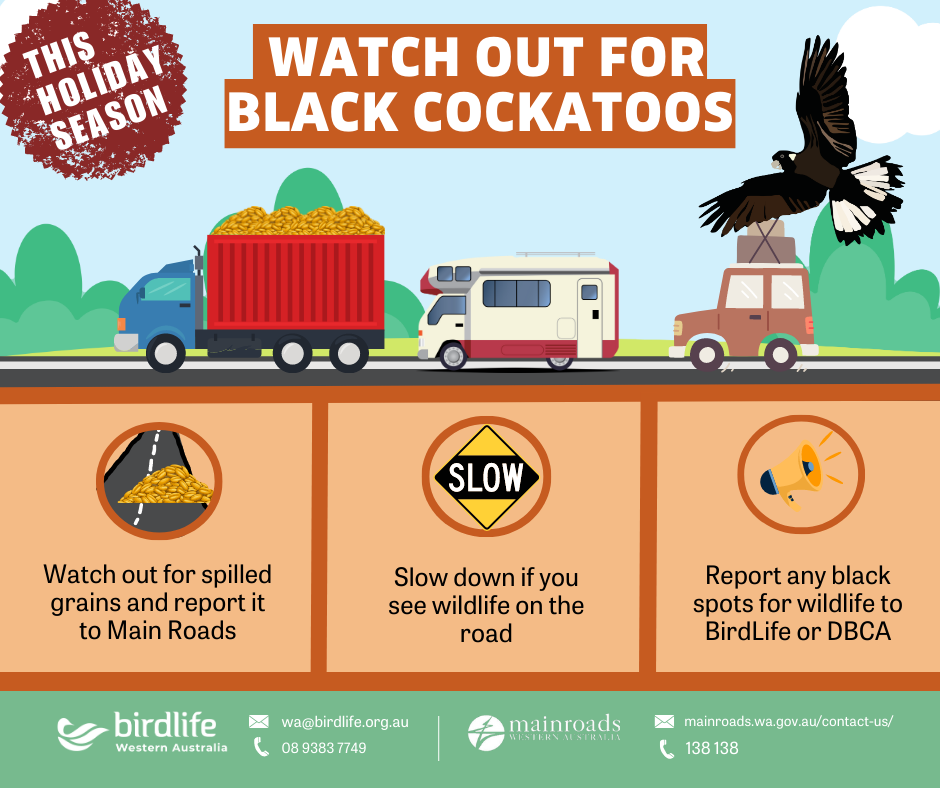From the desk of Dorothy, Communications Project Officer.
It is early evening on an autumn day near Esperance in Western Australia. I have a clipboard and pen in hand; a pair of binoculars and a thermos of hot cocoa sit on the empty passengers seat beside me. And I wait…
I am taking part in a stakeout.
Every April, the Great Cocky Count gives people like me the chance to participate in a citizen-science survey described by BirdLife Australia as the biggest single survey for black-cockatoos in Western Australia.
Our focus will be on the charmingly cheeky, loud-mouthed and pine-cone dropped Carnaby’s that frequent skies near our home, but the count covers an area south-west of a line between Geraldton and Esperance, and includes Baudin’s Black-Cockatoos and Forest Red-tailed Black-Cockatoos at sites across the South West.
In the lead up to the count, people are encouraged to attend workshops to learn more about black cockatoo biology, ecology, behaviour and threat.
The country provides a snapshot of where cockatoos are located, providing an idea of their numbers in the wild.
I sit, contemplating the impact we have had on the Carnaby’s, Calyptorhynchus latirostris. I have heard stories of flocks of the long-lived birds blackening the skies, before human impact took its toll. Farmers I know now admit to shooting the birds when they were numerous, with the damage to fruit trees demanding capital punishment.
The Department of Biodiversity, Conservation and Attractions states that the species range has been reduced by approximately 50 per cent, and is continuing to decline due to widespread clearing in the 1970s. The population is estimated at between 10,000 to 60,000 breeding individuals…a figure that will be clarified by the work we do this April.
Regularly, we count the birds that fly over our house near the Dalyup River. They announce their presence with their raucous chatter. It is hard to ignore them. They are loud. They are large. And they make us laugh.
Many times, as we have made our way along a section of the South Coast Highway that is shaded by lines of pine trees, our car roof has been drummed by cones dropped by foraging Carnaby’s —- always a shock and a jolt, but always amusing!
We often count between 30 and 50 birds. And there is one who flies alone. One of the most painful, achingly sad sights. A lone bird who should be with a flock. Why? What tragedy had befallen this singular creature?
We have seen them dead by the side of the highway, hit by fast moving vehicles as they gnaw on pine cones too close to the bitumen. They are brazen, and it seems like they are arrogantly assuming they do not need to move. The highway does not allow for such non-life-preserving behaviour.
While we see them regularly on their Dalyup River fly-by, the chances are I will see none this April evening. They roost in some places, feed in others. I may well luck out. My allocated observation site may see me write “0” in the space where I could insert a more rewarding integer. I may not see them gliding onto branches at sunset, but I will have enjoyed a quiet evening of hope, part of a project that has drawn together people who care about the birds, and the natural world that we all live in.


